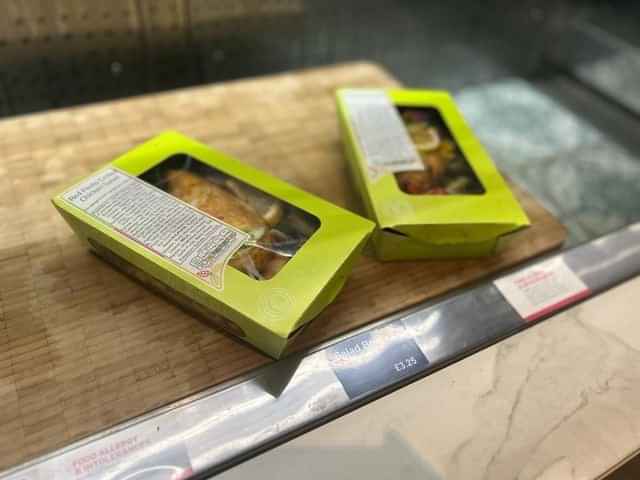A Brief History of Baguettes
Oui Brits can't get enough of the French baguette sandwich with global appeal.
06.04.18
The UK has done a solid line in French loaves for nearly forty years. Pret’s top three biggest selling sarnies are all baguette-based (chicken Caesar and bacon, tuna and cucumber and cheddar and pickle seeing as you’ve asked (1). Last year Planglow sold 5.3 million of our compostable baguette sandwich bags and we estimate that the baguette accounted for a quarter of all sandwiches sold within the UK. We would say that baguettes are the best thing since sliced bread if it wasn’t for the fact that baguettes predate a sliced loaf by eight whole years (yep not as much as we thought either – more on this later).
 The baguette – or French Stick as it was more commonly known - first came to our shores, in a big way, in the 1980’s, when it went from relative unknown to guest of honour seemingly overnight. Suddenly he was everywhere: picnics, dinner parties, buffets, weddings… sometimes as a straight up loaf, sometimes as a sandwich, occasionally as a ‘French bread pizza’ but perhaps most popular of all he was served up as an incredibly exciting new starter or side called ‘garlic bread’. As the baguette’s popularity burgeoned the high street followed suite. In 1986 baguette sandwich sellers Upper Crust first opened its doors, two years later Greggs began pumping out the pain and has never looked back. By 1990 M&S was so invested in its baguette offering it dabbled with a short lived scheme whereby loaves were baked fresh each morning in West London bakery then distributed throughout the capital (1).
The baguette – or French Stick as it was more commonly known - first came to our shores, in a big way, in the 1980’s, when it went from relative unknown to guest of honour seemingly overnight. Suddenly he was everywhere: picnics, dinner parties, buffets, weddings… sometimes as a straight up loaf, sometimes as a sandwich, occasionally as a ‘French bread pizza’ but perhaps most popular of all he was served up as an incredibly exciting new starter or side called ‘garlic bread’. As the baguette’s popularity burgeoned the high street followed suite. In 1986 baguette sandwich sellers Upper Crust first opened its doors, two years later Greggs began pumping out the pain and has never looked back. By 1990 M&S was so invested in its baguette offering it dabbled with a short lived scheme whereby loaves were baked fresh each morning in West London bakery then distributed throughout the capital (1).
At just 97 years young the baguette is fresh faced, relatively speaking, when you consider that in the not so brief history of bread the Egyptians first put grain to grindstone in 8000BC (2). Napoleon is sometimes cited as inventor of the baguette. Legend has it he requested a loaf that his troops could pop down their trouser legs and carry into battle - presumably transforming into an additional take-your-eye-out pokey stick weapon once stale. Sadly this wondrous tale is pure myth, more’s the pity. No the baguette was actually born of Austrian decent utilising the ‘Vienna technique’ (hot steam ovens that lend the loaves their golden hue) to new aplomb while the First World War was the catalyst for its creation. After the war bakers - along with the wider workforce in general - were pretty thin on the ground so the nation’s former favourite loaf, a labour intensive sourdough, fell by the wayside. Then in October 1920, the French government passed a new law preventing its bakers from so much as donning a piny before 4am. With time anything-but on their side, the bakers of France required a speedier solution to their previous go-to loaf, the fast-bake baguette answered all their prayers. What’s more, the unique dimensions of the baguette (the greatly increased surface-area-to-body ratio which make it so quick to cook in the first place) turned it stale at an equally accelerated rate which meant, alas, punters were stopping into the bakery for a second - if not third - loaf later in the day (3).
The French take their bread very seriously. In 1993 the government introduced the Le Décret Pain to help safeguard the legacy of the baguette, this states that a baguette must contain wheat flour, water, salt and yeast only and must be sold on the premises from which it was baked. Freezing at any stage is a no-no, likewise using preservatives of any kind. In 2013, a decade after Le Décret Pain was passed, France’s baguette sales had plummeted so come June, the country launched a campaign to help pep them up again. At that time there were 32,000+ artisan bakeries operating within the country (this has now risen to 33K). While this represented around one bakery to every 2000 people (it’s worth noting there is just one bakery to every 13K people in the UK (4)) boulangeries had declined 40% (from 54,000) since 1950 (5). Baguette consumption had dwindled too from nearly a full baguette per adult per day in 1970 to just half 43 years later (6). The usual suspects - breakfast-dodgers, dieters, pasta and ‘The Youth’ - were all to blame so campaign organisers CRÉDOC (the Centre of Research for the Study and Observation of Living Conditions) went straight for the heart strings. To purchase fresh bread on the way home, they said, was ‘a simple means of showing loved ones that you are thinking of them at the end of the day’ (7).
 Nearly five years on the number of boulangeries has risen to 33K and baguette sales remain strong. So strong in fact that in January, France launched a campaign calling for its baguettes to receive UNESCO status. Spearheaded by the French president himself Emmanuel Macron, the call came straight from the top, "Excellence and expertise must be preserved,” he said of his beloved loaves (8). Whether France’s bid will be successful remains to be seen. However, the city of Naples ‘pizzailuolo’ tradition (spinning pizza dough and then cooking the pizzas in a wood fired brick oven) was awarded UNESCO status last December so we’d say baguettes stand more than a fighting chance. The proof, as they say, will be in the dough.
Nearly five years on the number of boulangeries has risen to 33K and baguette sales remain strong. So strong in fact that in January, France launched a campaign calling for its baguettes to receive UNESCO status. Spearheaded by the French president himself Emmanuel Macron, the call came straight from the top, "Excellence and expertise must be preserved,” he said of his beloved loaves (8). Whether France’s bid will be successful remains to be seen. However, the city of Naples ‘pizzailuolo’ tradition (spinning pizza dough and then cooking the pizzas in a wood fired brick oven) was awarded UNESCO status last December so we’d say baguettes stand more than a fighting chance. The proof, as they say, will be in the dough.
View our Baguette Sandwich Bags in our Online Shop
Three Ways to Use Your Loaf
Très Français - Sandwiches aside baguettes make for a delicious petit dejeuner, keep ‘em sweet with fruity conserves or chocolatey spreads and serve with a bowl of creamy rich hot chocolate in which to dip.
Banh Mi – We could write a whole post alone on one of our all-time favourite Vietnamese dishes, the brilliant banh mi sandwich or Vietnamese sub. There are a million recipes out there from vegan to triple meat, our advice: your bread should be as fresh as possible – ideally still warm from the oven!
Strata – this North American classic is a favourite at brunch but also the kind of dish you can enjoy any time of day. In essence, you chop up a load of old bread, pop it in a casserole dish smothered in eggs and cheese then bake. You can add all sorts of other ingredients too such as bacon, sausage or spinach, this excellent recipe from Epicurious will help get you started. 
The Skinny on Baguettes
- There are 33000+ boulangère’s in France compared to just 5,000 bakeries in the UK
- 70% of French consumers buy bread from their local boulangère
- The baguette was invented in 1920, sliced bread 1928 (9)
- Average baguette consumption per adult in France by year:
-1920 – 3
-1970 – 1
-2013 – 0.5 - In addition to France, Belgium and Quebec are the biggest consumers of baguettes followed by Algeria, Vietnam, Cambodia and Tunisia (10)
- A classic baguette (meaning baton / stick) should be 55-65cm long (though it can go up to a meter) with a diameter of 5-6 cm whereas skinny mini ficelle (meaning string and often confused with a baguette) has a diameter of just 3-4cm!
1. TheGuardian.com
2. Encyclopedia.com
3. Foodtimeline.org
4. Craftbakersassociation.co.uk
5. Euromonitor.com
6. BBCgoodfood.com
7. Telegraph.co.uk
8. BBC.co.uk/news
9. Time.com
10. Finedininglovers.com




